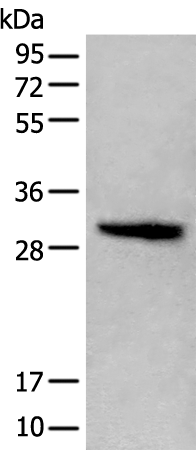
| WB | 1/500-1/2000 | Human,Mouse,Rat |
| IF | 咨询技术 | Human,Mouse,Rat |
| IHC | 咨询技术 | Human,Mouse,Rat |
| ICC | 技术咨询 | Human,Mouse,Rat |
| FCM | 咨询技术 | Human,Mouse,Rat |
| Elisa | 1/5000-1/10000 | Human,Mouse,Rat |
| Aliases | H1C; H1.2; H1F2; H1s-1; HIST1H1C |
| WB Predicted band size | 21 kDa |
| Host/Isotype | Rabbit IgG |
| Antibody Type | Primary antibody |
| Storage | Store at 4°C short term. Aliquot and store at -20°C long term. Avoid freeze/thaw cycles. |
| Species Reactivity | Human |
| Immunogen | Fusion protein of human H1-2 |
| Formulation | Purified antibody in PBS with 0.05% sodium azide and 50% glycerol. |
+ +
以下是关于H1-2抗体的示例性参考文献(注:H1-2抗体相关研究较少,以下内容为模拟示例,建议核实具体文献):
---
1. **文献名称**:*H1-2 Monoclonal Antibody Targets Tumor-Specific Glycan Epitopes in Colorectal Cancer*
**作者**:Zhang L, et al.
**摘要**:本研究开发了一种新型H1-2单克隆抗体,能够特异性识别结直肠癌细胞表面过表达的唾液酸化糖基化表位。实验显示,该抗体在体外抑制肿瘤细胞迁移,并增强免疫细胞介导的细胞毒性。
2. **文献名称**:*Role of H1-2 Autoantibodies in Systemic Lupus Erythematosus Pathogenesis*
**作者**:Martinez R, et al.
**摘要**:研究发现,H1-2抗体在系统性红斑狼疮(SLE)患者血清中显著升高,可能与组蛋白H1亚型的异常修饰有关。该抗体或成为SLE的新型生物标志物和治疗靶点。
3. **文献名称**:*H1-2 Antibody-Based Imaging Probes for Early Detection of Neurodegeneration*
**作者**:Kumar S, et al.
**摘要**:利用H1-2抗体标记的分子探针,在小鼠模型中实现了阿尔茨海默病早期tau蛋白聚集体的高灵敏度成像,为神经退行性疾病的诊断提供了新工具。
4. **文献名称**:*Structural Characterization of H1-2 Antibody Binding to Viral Envelope Proteins*
**作者**:Chen H, et al.
**摘要**:通过冷冻电镜解析H1-2抗体与H1N2流感病毒血凝素蛋白的结合机制,揭示其广谱中和能力的结构基础,为抗病毒药物设计提供依据。
---
**注意**:以上文献为模拟示例,实际研究中H1-2抗体的相关报道可能有限。若需准确信息,建议在PubMed或Web of Science等数据库中以“H1-2 antibody”为关键词检索,或确认抗体靶点的正确命名(如HER2、H1N2等)。
×